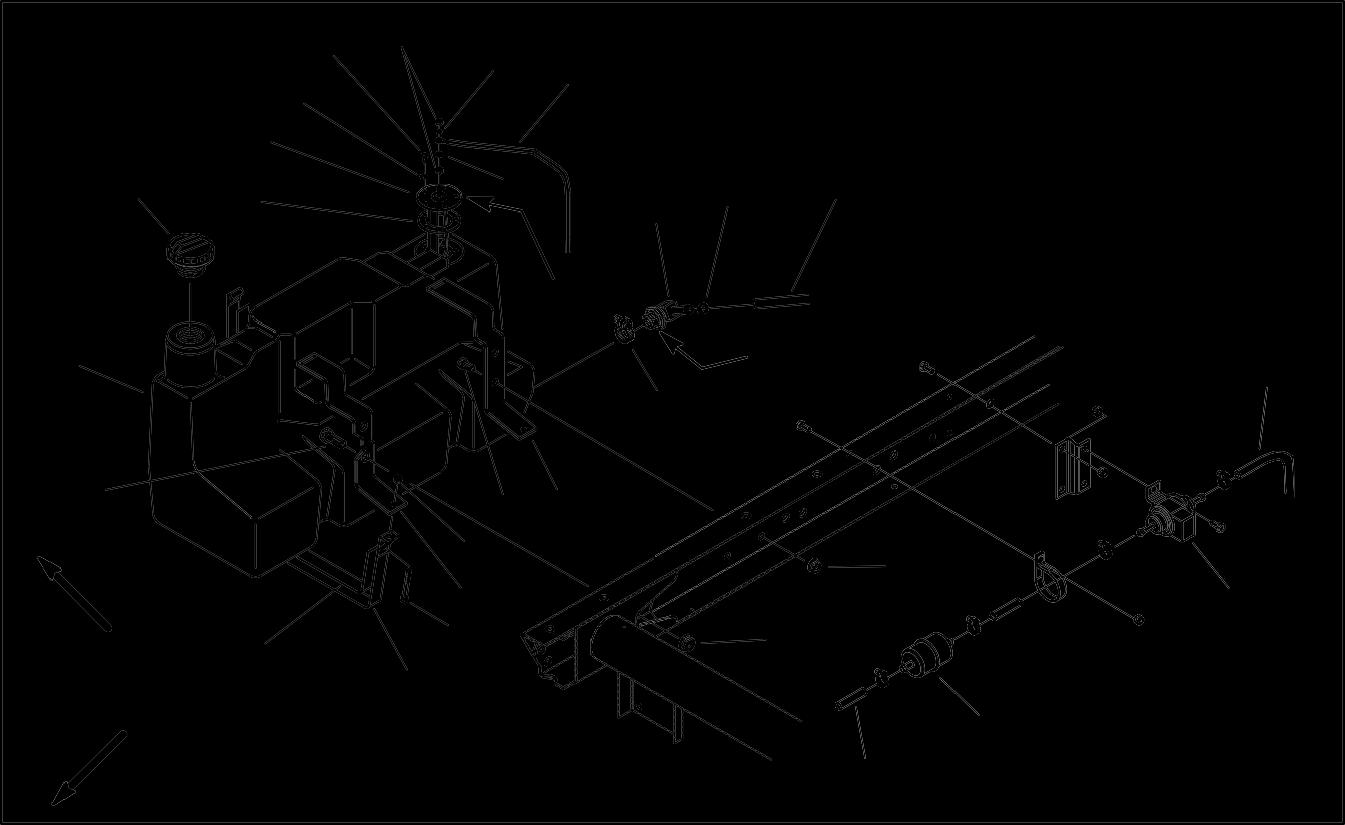WorkmanR 3000/4000 Series
Preface
The purpose of this publication is to provide the service technician with information for troubleshooting, testing, and repair of major systems and components on the Workman 3000/4000 Series vehicles.
REFER TO THE OPERATOR’S MANUAL FOR OPERATING, MAINTENANCE AND ADJUSTMENT INSTRUCTIONS. Space is provided in Chapter 2 of this book to insert the Operator’s Manuals and Parts Catalogs for your vehicle. Replacement Operator’s Manuals are available on the internet at www.toro.com.

The Toro Company reserves the right to change product specifications or this publication without notice.

This safety symbol means DANGER, WARNING, or CAUTION, PERSONAL SAFETY INSTRUCTION. When you see this symbol, carefully read the instructions that follow. Failure to obey the instructions may result in personal injury.


NOTE: A NOTE will give general information about the correct operation, maintenance, service, testing, or repair of the machine.
IMPORTANT: The IMPORTANT notice will give important instructions which must be followed to prevent damage to systems or components on the machine.
PART NO. 03126SL (Rev.D)
Service Manual (Serial No. 240000001 and Above)
E
- 2003, 2004, 2006, 2007, 2011
The Toro Company
This page is intentionally blank.


Chapter 1 - Safety Safety Instructions 1 - 2 Chapter 2 - Product Records and Maintenance Product Records 2 - 1 Equivalents and Conversions 2 - 2 Torque Specifications 2 - 3 Maintenance 2 - 7 Chapter 3 - Briggs/Daihatsu Gasoline Engine Introduction ................................ 3 - 1 Specifications .............................. 3 - 2 General Information ........................ 3 - 3 Adjustments 3 - 4 Service and Repairs ........................ 3 - 6 BRIGGS& STRATTON/DAIHATSU REPAIRMANUAL FOR 3 -CYLINDER, LIQUID -COOLED, GASOLINE ENGINES Chapter4 - Briggs/Daihatsu Diesel Engine Introduction 4 - 1 Specifications 4 - 2 General Information 4 - 3 Adjustments 4 - 4 Service and Repairs ........................ 4 - 6 BRIGGS& STRATTON/DAIHATSU REPAIRMANUAL FOR 3 -CYLINDER, LIQUID -COOLED, DIESEL ENGINES Chapter 5 - Kohler Gasoline Engine Introduction 5 - 1 Specifications 5 - 2 Service and Repairs 5 - 3 KOHLER ENGINE SERVICE MANUAL Workman 3000/4000 Series Chapter 6 - Drive Train General Information 6 - 2 Specifications 6 - 3 Special Tools 6 - 4 Adjustments 6 - 5 Troubleshooting 6 - 6 Service and Repairs 6 - 10 Chapter 7 - Chassis Specifications 7 - 2 Special Tools 7 - 3 Troubleshooting 7 - 4 Service and Repairs 7 - 8 Chapter 8 - Electrical System Electrical Schematics 8 - 2 Special Tools 8 - 2 Troubleshooting 8 - 3 Electrical System Quick Checks 8 - 5 Component Testing 8 - 7 Service and Repairs ....................... 8 - 17 Chapter 9 - Hydraulic System Specifications 9 - 3 General Information 9 - 4 Hydraulic Schematics 9 - 6 Hydraulic Circuit Operation 9 - 8 Special Tools 9 - 10 Troubleshooting ........................... 9 - 12 Testing ................................... 9 - 15 Service and Repairs 9 - 25 SAUER/DANFOSS STEERING UNIT TYPE OSPM SERVICE MANUAL Hydraulic System Chassis Drive Train Kohler Briggs/Daihatsu Briggs/Daihatsu Product Records Safety Electrical System Gasoline Engine Diesel Engine Gasoline Engine and Maintenance
Table Of Contents
This page is intentionally blank.
Workman 3000/4000 Series
Chapter 10 - Front Wheel Drive (4WD) Specifications 10 - 2 General Information Service and Repairs 10 - 3 10 - 4 Chapter 11 - Electrical Schematics Vehicle Electrical Schematics 11 - 3 Wire Harness Drawings 11 - 10 Workman 3000/4000 Series Rev. C Electrical Schematics Front Wheel Drive (4WD)
Table Of Contents
This page is intentionally blank.
Workman 3000/4000 Series

Table of Contents SAFETY INSTRUCTIONS 2 Before Operating 2 While Operating 3 Maintenance and Service 4 Jacking Vehicle 5 Using Bed Safety Support 6 Chapter 1 Safety Workman 3000/4000 Series Page 1 – 1 Safety Safety
Safety Instructions
The Workman 3000/4000 series vehicles are designed and tested to offer safe service when operated and maintained properly. Although hazard control and accident prevention are partially dependent upon the design and configuration of the vehicle, these factors are also dependent upon the awareness, concern, and proper training of the personnel involved in the operation, transport, maintenance, and storage of the vehicle. Improper use or maintenance of the vehicle can result in injury or
Before Operating
1. Read and understand the contents of the Operator’s Manual and Operator’s Video before starting and operating the vehicle. Become familiar with the controls and know how to stop the vehicle and engine quickly. A replacement Operator’s Manual is available on the Internet at www.Toro.com.
2. Keep all shields, safety devices, and decals in place. If a shield, safety device, or decal is defective, illegible or damaged, repair or replace it before operating the vehicle. Also tighten any loose nuts, bolts or screws to ensure vehicle is in safe operating condition.
3. Assure interlock switches are adjusted correctly so engine cannot be started unless clutch pedal is depressed. On TC models, engine should start only when hydraulic lever is in the neutral position. On vehicles equipped with the optional PTO kit, engine should start only when PTO is disengaged.
death.Toreducethepotentialforinjuryordeath,comply with the following safety instructions.
WARNING
To reduce the potential for injury or death, comply with the following safety instructions.
4. Since fuel used in Workman vehicles is highly flammable, handle it carefully:
A. Store fuel in containers specifically designed for this purpose.

B. Do not remove vehicle fuel tank cap while engine is hot or running.
C. Do not smoke while handling fuel.
D. Fill fuel tank outdoors and only to within an inch of the top of the tank, not the filler neck. Do not overfill the fuel tank.
E. Wipe up any spilled fuel.
Safety Page 1 - 2 Rev. D Workman 3000/4000 Series
While Operating
1. Sit on the seat when starting and operating the vehicle.
2. Before starting the engine:
A. Sit on operator’s seat and engage the parking brake.
B. Disengage PTO (if so equipped) and return hand throttle lever to OFF position (if so equipped).
C. On TC models, make sure that hydraulic lever is in the neutral position.
D. Move shift lever to NEUTRAL and depress clutch pedal. Keep foot off accelerator pedal.
E. Turn ignition key to START.
3. Do not run engine in a confined area without adequate ventilation. Exhaust fumes are hazardous and could possibly be deadly.
4. Do not touch engine, radiator, muffler or exhaust pipe while engine is running or soon after it is stopped. These areas could be hot enough to cause burns.
5. Before getting off the seat:
A. Stop movement of the vehicle.
B. Lower bed.
C. Shut engine off and wait for all movement to stop.
D. Set parking brake and remove key from ignition switch.
E. Do not park on slopes unless wheels are chocked or blocked.
Workman 3000/4000 Series Page 1 – 3 Safety Safety
Maintenance and Service
1. Before servicing or making adjustments, turn all accessories off, put traction pedal in neutral, stop engine, set parking brake, and remove key from the switch.
2. Make sure vehicle is in safe operating condition by keeping all nuts, bolts and screws tight.
3. Never store the vehicle or fuel container inside where there is an open flame, such as near a water heater or furnace.
4. Make sure all hydraulic line connectors are tight and that all hydraulic hoses and lines are in good condition, before applying pressure to the system.
5. Keep body and hands away from pin hole leaks in hydraulic lines that eject high pressure hydraulic fluid. Use cardboard or paper to find hydraulic leaks. Hydraulic fluid escaping under pressure can penetrate skin and cause injury. Fluid accidentally injected into the skin must be surgically removed within a few hours by a doctor familiar with this form of injury or gangrene may result.
6. Before disconnecting or performing any work on the hydraulic system, all pressure in hydraulic system must be relieved. To relieve system pressure, push dump lever forward and backward and rotate steering wheel in both directions after the key switch has been turned off.
7. If major repairs are ever needed or assistance is desired, contact an Authorized Toro Distributor.
8. To reduce potential fire hazard, keep engine area free of excessive grease, grass, leaves and dirt. Clean protective screen on vehicle frequently.
9. If engine must be running to perform maintenance or an adjustment, keep clothing, hands, feet, and other parts of the body away from moving parts. Keep bystanders away.
10.Do not overspeed the engine by changing governor setting. To assure safety and accuracy, check maximum engine speed.
11.Shut engine off before checking or adding oil to the engine crankcase.
12.Disconnect battery before servicing the vehicle. Disconnect negative (–) battery cable first and positive (+) cable last. If battery voltage is required for troubleshooting or test procedures, temporarily connect the battery. Reconnect positive (+) cable first and negative (–) cable last.
13.Battery acid is poisonous and can cause burns. Avoid contact with skin, eyes, and clothing. Protect your face, eyes, and clothing when working with a battery.
14.Battery gases can explode. Keep cigarettes, sparks, and flames away from the battery.
15.To assure optimum performance and continued safety of the vehicle, use genuine Toro replacement parts and accessories. Replacement parts and accessories made by other manufacturers may result in nonconformance with safety standards, and the warranty may be voided.
16.When raising the vehicle to change tires or to perform other service, use correct blocks, hoists, and jacks. Make sure vehicle is parked on a solid level surface such as a concrete floor. Prior to raising the vehicle, remove any attachments that may interfere with the safe and proper raising of the vehicle. Always chock or block wheels. Use jack stands or solid wood blocks to support the raised vehicle. If the vehicle is not properly supported by blocks or jack stands, the vehicle may move or fall, which may result in personal injury (see Jacking Instructions in Operator’s Manual).
Safety Workman 3000/4000 Series Page 1 – 4
When changing attachments, tires or performing other service, use the correct blocks, hoists and jacks. Always chock or block the wheels and use jack stands or solid wood blocks to support the vehicle. If the vehicle is not properly supported by blocks or jack stands, the vehicle may move or fall resulting in personal injury.

1. Do not start engine while vehicle is on jack, because engine vibration or wheel movement could cause vehicle to slip off jack.
2. Do not work under vehicle without jack stands supporting it. The vehicle could slip off jack, injuring any one beneath it.



3. The jacking point at the front of the vehicle is under the front center frame support and at the rear it is under the axle tube.

4. When jacking up front of vehicle, always place a wood block (or similar material) between jack and vehicle frame support.

Workman 3000/4000 Series Safety Page 1 - 5
WARNING Jacking Vehicle
Figure 1
1. Front jacking point
Figure 2
1
1. Rear jacking point
1 1 Safety
Using Bed Safety Support
Many of the procedures shown in this manual require raising and lowering the bed. The following precautions must be taken or serious injury or death could result.
Before servicing or making adjustments to the vehicle, stop engine, set parking brake and remove key from ignition switch. Any load material must be removed from bed or other attachment before working under raised bed. Never work under a raised bed without positioning bed safety support on a fully installed cylinder rod.
After work is completed, remove bed safety support, insert into storage brackets on back of ROPS panel and lower bed.
1. Raise bed until lift cylinders are fully extended.
2. Remove bed safety support from storage brackets on back of ROPS panel.
3. Push bed safety support onto cylinder rod, making sure support end tabs rest on end of cylinder barrel and on cylinder rod end (Fig. 3).

4. To store bed safety support, remove support from cylinder and insert into storage brackets on back of ROPS panel.
5. Always install or remove bed safety support from outside of bed.
6. Do not try to lower bed with bed safety support on cylinder: cylinder and bed damage may occur.

Safety Workman 3000/4000 Series Page 1 – 6
1. Bed safety support
2. Cylinder barrel
WARNING 1 3
Figure 3 3. Bed
2
Product Records and Maintenance
Product Records
Insert Operator’s Manual and Parts Catalog for your Workman at the end of this chapter. Refer to Operator’s Manual for recommended maintenance intervals. Additionally, insert Installation Instructions, Operator’s Manuals, Parts Catalogs and Service Manuals for any accessories that have been installed on your Workman at the end of this section.

Workman 3000/4000 Series Page 2 – 1 Product Records and Maintenance Chapter 2
of
PRODUCT RECORDS 1 EQUIVALENTS AND CONVERSIONS 2 Decimal and Millimeter Equivalents 2 U.S. to Metric Conversions 2 TORQUE SPECIFICATIONS...................................... 3 Fastener Identification 3 Standard Torque for Dry, Zinc Plated, and Steel Fasteners (Inch Series Fasteners) 4 Standard Torque for Dry, Zinc Plated, and Steel Fasteners (Metric Fasteners) 5 Other Torque Specifications 6 Conversion Factors 6 MAINTENANCE 7
Table
Contents
Product Records and Maintenance
Equivalents and Conversions

0.09375 Product Records and Maintenance Page 2 - 2 Rev. D Workman 3000/4000 Series
Torque Specifications
Recommended fastener torque values are listed in the following tables. For critical applications, as determined by Toro, either the recommended torque or a torque that is unique to the application is clearly identified and specified in this Service Manual.
These Torque Specifications for the installation and tightening of fasteners shall apply to all fasteners which do not have a specific requirement identified in this Service Manual. The following factors shall be considered when applying torque: cleanliness of the fastener, use of a thread sealant (Loctite), degree of lubrication on the fastener, presence of a prevailing torque feature, hardness of the surface underneath the fastener’s head, or similar condition which affects the installation.
Fastener Identification
As noted in the following tables, torque values should be reduced by 25% for lubricated fasteners to achieve the similar stress as a dry fastener. Torque values may also have to be reduced when the fastener is threaded into aluminum or brass. The specific torque value should be determined based on the aluminum or brass material strength, fastener size, length of thread engagement, etc.




The standard method of verifying torque shall be performed by marking a line on the fastener (head or nut) and mating part, then back off fastener 1/4 of a turn. Measure the torque required to tighten the fastener until the lines match up.

Workman 3000/4000 Series Page 2 – 3 Product Records and Maintenance
Grade 1
Grade 5
Grade 8
Class 8.8
Class 10.9
Inch Series Bolts and Screws
Product Records and Maintenance
Metric Bolts and Screws
Standard Torque for Dry, Zinc Plated, and Steel Fasteners (Inch Series Fasteners)
NOTE: Reduce torque values listed in the table above by 25% for lubricated fasteners. Lubricated fasteners are defined as threads coated with a lubricant such as oil, graphite, or thread sealant such as Loctite.
NOTE: Torque values may have to be reduced when installing fasteners into threaded aluminum or brass. The specific torque value should be determined based
on the fastener size, the aluminum or base material strength, length of thread engagement, etc.
NOTE: The nominal torque values listed above for Grade 5 and 8 fasteners are based on 75% of the minimum proof load specified in SAE J429. The tolerance is approximately + 10% of the nominal torque value. Thin height nuts include jam nuts.
Product Records and Maintenance Page 2 – 4 Workman 3000/4000 Series
Thread Size Grade 1, 5, & 8 with Thin Height Nuts SAE Grade 1 Bolts, Screws, Studs, & Sems with Regular Height Nuts (SAE J995 Grade 2 or Stronger Nuts) SAE Grade 5 Bolts, Screws, Studs, & Sems with Regular Height Nuts (SAE J995 Grade 2 or Stronger Nuts) SAE Grade 8 Bolts, Screws, Studs, & Sems with Regular Height Nuts (SAE J995 Grade 5 or Stronger Nuts) in–lb in–lb N–cm in–lb N–cm in–lb N–cm # 6 – 32 UNC 10 + 2 13 + 2 147 + 23 15 + 2 170 + 20 23 + 2 260 + 20 # 6 – 40 UNF 17 + 2 190 + 20 25 + 2 280 + 20 # 8 – 32 UNC 13 + 2 25 + 5 30 + 5 282 + 30 339 + 56 29 + 3 330 + 30 41 + 4 460 + 45 31 + 3 # 8 – 36 UNF 350 + 30 43 + 4 485 + 45 # 10 – 24 UNC 18 + 2 42 + 4 475 + 45 60 + 6 675 + 70 # 10 – 32 UNF 48 + 4 540 + 45 68 + 6 765 + 70 1/4 – 20 UNC 48 + 7 53 + 7 599 + 79 100 + 10 1125 + 100 140 + 15 1580 + 170 1/4 – 28 UNF 53 + 7 65 + 10 734 + 113 115 + 10 1300 + 100 160 + 15 1800 + 170 5/16 – 18 UNC 115 + 15 105 + 17 1186 + 169 200 + 25 2250 + 280 300 + 30 3390 + 340 5/16 – 24 UNF 138 + 17 128 + 17 1446 + 192 225 + 25 2540 + 280 325 + 30 3670 + 340 ft–lb ft–lb N–m ft–lb N–m ft–lb N–m 3/8 – 16 UNC 16 + 2 16 + 2 22 + 3 30 + 3 41 + 4 43 + 4 58 + 5 3/8 – 24 UNF 17 + 2 18 + 2 24 + 3 35 + 3 47 + 4 50 + 4 68 + 5 7/16 – 14 UNC 27 + 3 27 + 3 37 + 4 50 + 5 68 + 7 70 + 7 95 + 9 7/16 – 20 UNF 29 + 3 29 + 3 39 + 4 55 + 5 75 + 7 77 + 7 104 + 9 1/2 – 13 UNC 30 + 3 48 + 7 65 + 9 75 + 8 102 + 11 105 + 10 142 + 14 1/2 – 20 UNF 32 + 3 53 + 7 72 + 9 85 + 8 115 + 11 120 + 10 163 + 14 5/8 – 11 UNC 65 + 10 88 + 12 119 + 16 150 + 15 203 + 20 210 + 20 285 + 27 5/8 – 18 UNF 75 + 10 95 + 15 129 + 20 170 + 15 230 + 20 240 + 20 325 + 27 3/4 – 10 UNC 93 + 12 140 + 20 190 + 27 265 + 25 359 + 34 375 + 35 508 + 47 3/4 – 16 UNF 115 + 15 165 + 25 224 + 34 300 + 25 407 + 34 420 + 35 569 + 47 7/8 – 9 UNC 140 + 20 225 + 25 305 + 34 430 + 45 583 + 61 600 + 60 813 + 81 7/8 – 14 UNF 155 + 25 260 + 30 353 + 41 475 + 45 644 + 61 660 + 60 895 + 81
NOTE: Reduce torque values listed in the table above by 25% for lubricated fasteners. Lubricated fasteners are defined as threads coated with a lubricant such as oil, graphite, or thread sealant such as Loctite.
NOTE: Torque values may have to be reduced when installing fasteners into threaded aluminum or brass. The specific torque value should be determined based
on the fastener size, the aluminum or base material strength, length of thread engagement, etc.
NOTE: The nominal torque values listed above are based on 75% of the minimum proof load specified in SAE J1199. The tolerance is approximately + 10% of the nominal torque value.
Workman 3000/4000 Series Page 2 – 5 Product Records and Maintenance Standard Torque
Dry, Zinc Plated,
Thread Size Class 8.8 Bolts, Screws, and Studs with Regular Height Nuts (Class 8 or Stronger Nuts) Class 10.9 Bolts, Screws, and Studs with Regular Height Nuts (Class 10 or Stronger Nuts) M5 X 0.8 57 + 5 in–lb 640 + 60 N–cm 78 + 7 in–lb 885 + 80 N–cm M6 X 1.0 96 + 9 in–lb 1018 + 100 N–cm 133 + 13 in–lb 1500 + 150 N–cm M8 X 1.25 19 + 2 ft–lb 26 + 3 N–m 27 + 2 ft–lb 36 + 3 N–m M10 X 1.5 38 + 4 ft–lb 52 + 5 N–m 53 + 5 ft–lb 72 + 7 N–m M12 X 1.75 66 + 7 ft–lb 90 + 10 N–m 92 + 9 ft–lb 125 + 12 N–m M16 X 2.0 166 + 15 ft–lb 225 + 20 N–m 229 + 22 ft–lb 310 + 30 N–m M20 X 2.5 325 + 33 ft–lb 440 + 45 N–m 450 + 37 ft–lb 610 + 50 N–m
for
and Steel Fasteners (Metric Fasteners)
Product Records and Maintenance
Other Torque Specifications
** For steel wheels and non–lubricated fasteners.
* Hole size, material strength, material thickness & finish must be considered when determining specific torque values. All torque values are based on non–lubricated fasteners.
Product Records and Maintenance Page 2 – 6 Workman 3000/4000 Series Thread Size Recommended Torque Square Head Hex Socket 1/4 – 20 UNC 140 + 20 in–lb 73 + 12 in–lb 5/16 – 18 UNC 215 + 35 in–lb 145 + 20 in–lb 3/8 – 16 UNC 35 + 10 ft–lb 18 + 3 ft–lb 1/2 – 13 UNC 75 + 15 ft–lb 50 + 10 ft–lb Thread Size Recommended Torque** 7/16 – 20 UNF Grade 5 65 + 10 ft–lb 88 + 14 N–m 1/2 – 20 UNF Grade 5 80 + 10 ft–lb 108 + 14 N–m M12 X 1.25 Class 8.8 80 + 10 ft–lb 108 + 14 N–m M12 X 1.5 Class 8.8 80 + 10 ft–lb 108 + 14 N–m
Wheel
SAE Grade 8 Steel Set Screws
Bolts and Lug Nuts
Thread Cutting Screws Thread Cutting Screws (Zinc Plated Steel) (Zinc Plated Steel) Thread Size Threads per Inch Baseline Torque* Type A Type B No. 6 18 20 20 + 5 in–lb No. 8 15 18 30 + 5 in–lb No. 10 12 16 38 + 7 in–lb No. 12 11 14 85 + 15 in–lb
Conversion Factors in–lb X 11.2985 = N–cm N–cm X 0.08851 = in–lb ft–lb X 1.3558 = N–m N–m X 0.7376 = ft–lb Type 1, Type 23, or Type F Thread Size Baseline Torque* No. 6 – 32 UNC 20 + 5 in–lb No. 8 – 32 UNC 30 + 5 in–lb No. 10 – 24 UNC 38 + 7 in–lb 1/4 – 20 UNC 85 + 15 in–lb 5/16 – 18 UNC 110 + 20 in–lb 3/8 – 16 UNC 200 + 100 in–lb
Maintenance
Maintenance procedures and recommended service intervals for the Workman 3000/4000 are covered in the Operator’s Manual. Refer to that publication when performing regular equipment maintenance. Several maintenance procedures have break–in intervals identified in the Operator’s Manual. Refer to the Engine Operator’s Manual for additional engine specific maintenance procedures.
Workman 3000/4000 Series Page 2 – 7 Product Records and Maintenance
Product Records and Maintenance
This page is intentionally blank.
Product Records and Maintenance Page 2 – 8 Workman 3000/4000 Series
Briggs/Daihatsu Gasoline Engine
This Chapter gives information about specifications and repair of the Briggs & Stratton/Daihatsu 3LC gasoline engine used in the Workman 3200 and 4200.

General engine maintenance procedures are described in your Operator’s Manual. Information on engine troubleshooting, testing, disassembly, and reassembly is identified in the Briggs & Stratton/Daihatsu Repair Manual that is included at the end of this section.
Most repairs and adjustments require tools which are commonly available in many service shops. Special tools are described in the Briggs & Stratton/Daihatsu Repair Manual. The use of some specialized test equipment is explained. However, the cost of the test equipment and the specialized nature of some repairs may dictate that the work be done at an engine repair facility.
Service and repair parts for Briggs & Stratton/Daihatsu 3LC gasoline engines are supplied through your local Toro distributor.
Workman 3200/4200 Briggs/Daihatsu Gasoline Engine Page 3 – 1
Chapter 3
Table of Contents INTRODUCTION 1 SPECIFICATIONS 2 GENERAL INFORMATION 3 Adding Oil to Engine 3 ADJUSTMENTS 4 Engine Speed Adjustment 4 SERVICE AND REPAIRS............................................6 Radiator ...................................................................6 Pump Driveshaft Service..........................................8 Fuel Tank 10 Air Cleaner System 12 Exhaust System 14 Engine 16 Engine Throttle Bracket 20 BRIGGS & STRATTON/DAIHATSU REPAIR MANUAL
CYLINDER,
Introduction
FOR 3–
LIQUID–COOLED, GASOLINE ENGINES
Briggs/Daihatsu Gasoline Engine
Specifications Item Description Make / Designation Briggs &Stratton/Daihatsu, 4–stroke, Liquid Cooled, OHV Gasoline Number of Cylinders 3 Bore x Stroke mm (in.) 72 x 78 (2.834 x 3.07) Total Displacement cc (cu. in.) 952 (58.1) Compression Ratio 8.6:1 Firing Order 1 (front) – 2 – 3 Dry Weight (approximate) kg (lb.) 62 (137) Carburetor Single barrel, float feed, 12 VDC shut–off solenoid Fuel Pump 12 VDC Fuel Unleaded, regular grade (87 octane minimum) Fuel Tank Capacity liter (U.S. gal.) 26 (7) Governor Mechanical Idle Speed (no load) 1100 + 50 RPM High Idle (no load) 3600 + 50 RPM Engine Oil API Service Classification SH or better (see Operator’s Manual for viscosity) Oil Pump Gear driven trochoid type Crankcase Oil Capacity liter (U.S. qt.) 3.3 (3.5) with filter Water Pump Belt driven centrifugal type Cooling System Capacity liter (U.S. qt.) 3.8 (4.0) Starter 12 VDC Alternator/Regulator 12 VDC 40 AMP
Briggs/Daihatsu Gasoline Engine Workman 3200/4200 Page 3 – 2
General Information



Adding Oil to Engine
When adding oil to the engine, maintain clearance between the oil fill device and the oil fill opening in the valve cover (Fig. 1). This clearance is necessary to allow venting when adding engine oil which will prevent oil from running into the breather tube and intake system.
Page 3 – 3
Workman 3200/4200 Briggs/Daihatsu Gasoline Engine
Figure 1
Briggs/Daihatsu Gasoline Engine
Adjustments
Engine Speed Adjustment
1. Park vehicle on a level surface, engage parking brake and place gear shift lever in neutral.















2. Raise the bed or remove attachment(s) to allow access to engine. If bed is raised, place safety support on lift cylinder (see Operator’s Manual).
3. Stop engine and remove key from the ignition switch.
4. Make sure governor spring is assembled to bellcrank



on throttle bracket and outer most slot in engine governor lever (Fig. 2).

5. Check lowidle stopscrew adjustment (Figs. 3,4 and 5). Proper low idle stop screw adjustment will prevent engine run on when the accelerator pedal is released:

A. Remove return spring from throttle bracket and bellcrank. Disconnect throttle cable from balljoint on bellcrank.

B. Move the governor lever to its rearmost position and check that the governor spring is loose in the slot on the engine governor lever. Also, check that the rear edge of the bellcrank is against the low idle stop screw. Release governor lever.
C. Position the rear edge of the bellcrank so it is 0.125 in. (3.2 mm) from the head of the low idle stop
screw (Fig. 4). At this position, the governor spring must be tight against the upper edge of the engine governor lever slot with no extension of the spring


coils. If necessary, adjust low idle stop screw and/or governor spring adjusting rod (if equipped) to allow correct governor spring positioning.
D. Install return spring to throttle bracket and bellcrank. Connect throttle cable to balljoint on bellcrank.
6. Check operation and adjustment of accelerator cable (see Operator’s Manual). If needed, adjust accelerator cable.
7. Start andrun engine until engineis atnormal operating temperature. Make sure that carburetor choke is fully open.

Briggs/Daihatsu Gasoline Engine Page 3 – 4 Rev. B Workman 3200/4200
Figure 2
1. Engine governor lever 2. Governor spring
3. Spring mounting slot
1. Governor spring 2. Bellcrank
Figure 3 4. High idle stop screw 5. Low idle stop screw
3. Engine governor lever 6. Return spring
1. Governor spring 2. Bellcrank
Figure 4 4. High idle stop screw 5. Low idle stop screw
2 1 3 NOT EQUIPPED WITH GOVERNOR
ADJUSTING ROD 4 6 2 3 1 5 EQUIPPEDWITHGOVERNOR
ADJUSTING ROD 6 4 3 2 1 5 (0.125” (3.2 mm)
3. Engine governor lever 6. Spring adjusting rod
SPRING
SPRING
8. Using a tachometer, check low idle speed. Low idle speed should be 1100 + 50 RPM. If low idle is incorrect, repeat idle stop screw adjustment (step 5). If low idle is still incorrect, adjust the idle speed screw on the carburetor to obtain 1100 + 50 RPM (Fig. 6).

9. Check high idle speed. High idle speed should be 3600 + 50 RPM. Reposition the high idle stop screw to adjust high idle speed. Make sure to tighten lock nut after adjusting high idle stop screw.
10.After engine speed adjustments are complete, lower the bed or install attachment(s).


Workman
Page 3 – 5
3200/4200
Rev. B Briggs/Daihatsu Gasoline Engine
1. Throttle bracket
2. High idle stop screw
3. Idle stop screw
4. Governor spring
1. Governor link
2. Idle speed screw
Figure 5
5. Bellcrank
6. Jam nut
7. Return spring
8. Adj rod (if equipped)
Figure 6
6 7 5 6 4 8 3 2 1 1 2 3
3. Carburetor
Briggs/Daihatsu Gasoline Engine
Service and Repairs
Radiator

Briggs/Daihatsu Gasoline Engine Workman 3200/4200 Page 3 – 6
1. Hydraulicpump
2. Carriage screw (4 used)
3. Fan hub/pulley
4. Fan shroud
5. Lower radiator hose
6. Hose clamp
7. Radiator
8. Lock nut (4 used)
9. Cap screw (4 used)
Figure 5
10. Flange nut (4 used)
11. Magnetic catch (2 used)
12. Radiator cap
13. Hose (to coolant reservoir)
14. Cap screw (4 used)
15. Hose clamp
16. Upper radiator hose
17. Screw (2 used)
18. Flat washer
19. Lock nut (4 used)
20. Handle
21. Radiator cover/screen
22. Cap screw (4 used)
23. Lock washer (4 used)
24. Fan
25. Idler pulley
20 21 26 1 25 22 23 24 18 19 RIGHT 16 17 FRONT 15 14 13 12 2 3 11 10 4 5 6 7 8 9
26. Mount plate
Removal (Fig. 5)
1. Park vehicle on a level surface, stop engine, engage parking brake, and remove key from the ignition switch. Allow engine to cool.
2. Raise or remove the bed or other attachment(s). If bed is raised, place safety support on lift cylinder (see Operator’s Manual).
3. Lift and remove the radiator screen from front of radiator.
CAUTION
Do not open radiator cap or drain coolant if the radiator or engine is hot. Pressurized, hot coolant can escape and cause burns.
Ethylene–glycol antifreeze is poisonous. Dispose of coolant properly, or store it in a properly labeled container away from children and pets.
4. Remove the radiator cap. Drain radiator into a suitable container using the radiator drain located on the lower right corner of the radiator.
5. Disconnect upper and lower radiator hoses from the radiator.
6. Disconnect reservoir hose (item 13) from the radiator filler neck.
7. Detach fan shroud from the radiator by removing four (4) cap screws, flat washers and lock nuts. Position shroud away from radiator.
8. Remove four (4) cap screws and flange nuts that secure the radiator to the frame. Pull radiator from the vehicle.
9. Plug all radiator and hose openings to prevent contamination.
Installation (Fig. 5)

1. Remove plugs from radiator and hoses placed during the removal procedure.
2. Position radiator to the frame. Secure radiator to the vehicle with four (4) cap screws and flange nuts.
3. Attach fan shroud to the radiator with four (4) cap screws, flat washers and lock nuts. Make sure that clearance exists between shroud and fan at all points.
4. Connect reservoir hose (item 11) to the radiator filler neck.
5. Connect upper and lower hoses to the radiator.
6. Make sure radiator drain is closed. Fill radiator with coolant (see Operator’s Manual).
7. Install the radiator screen.
8. Lower or install bed or other attachment(s).
Workman 3200/4200 Briggs/Daihatsu Gasoline Engine Page 3 – 7
Briggs/Daihatsu Gasoline Engine
Pump Driveshaft Service

Briggs/Daihatsu Gasoline Engine Workman 3200/4200 Page 3 – 8
Figure 6
1. Lock nut
7. Bearing spacer
2. Flat washer
8. Shaft
3. Woodruff key
9. Lock nut (6 used)
4. Pump drive belt
10. Frame support bracket
5. Pulley
11. Cap screw (4 used)
6. Bearing 12. Coupling spacer (4 used)
(2 used) 18. Driveshaft 11 RIGHT 18 14 9 FRONT 12 11 14 10 12 13 100 to 130 in–lb (11.3 to 14.7 N–m) 15 17 13 16 15 8 9 7 3 6 6 5 ANTISIEZE
1 4 2
13. Coupling spacer (4 used) 14. Rubber coupling 15. Flat washer (4 used) 16. Cap screw (2 used)
17. Cap screw
LUBRICANT
Removal (Fig. 6)
1. Park vehicle on a level surface, raise and support bed (if installed), shut engine off and engage the parking brake.
2. Disassemble driveshaft using Figure 6 as a guide.
3. Do not reuse bearings (Item 6) if they have been removed from frame support bracket. Replace with new bearings.
Inspection
1. Inspect frame support bracket for wear or damage.
2. Inspect bearing spacer (Item 7) for wear or damage. Also, check that spacer length is from 1.884” to 1.894” (47.85 to 48.10 mm). Replace spacer if necessary.
Installation (Fig. 6)
1. To install bearings (Item 6) into frame support bracket:
A. Install pulley side bearing into support bracket by pressing on bearing outer race until bearing contacts shoulder in support bracket.
B. Place the bearing spacer (Item 7) into bracket cavity.
C. Install second bearing into bracket by pressing on the bearing outer race until bearing inner race contacts spacer.
2. Slide shaft (Item 8) into installed bearings in frame support bracket. Apply antisieze lubricant to pulley end of shaft before installing woodruff key (Item 3) and pulley (Item 5).
3. Secure pulley to shaft with washer and lock nut. Torque lock nut from 100 to 130 in–lb (11.3 to 14.7 N–m). Make sure that shaft rotates freely after pulley is installed.
4. Assemble driveshaft using Figure 6 as a guide.
5. Adjust pump drive belt tension after assembly (see Operator’s Manual).

Workman 3200/4200 Briggs/Daihatsu Gasoline Engine Page 3 – 9
Briggs/Daihatsu Gasoline Engine
Fuel Tank


6 7 8 5 9 4 2 3 10 13 11 12 Sender Ground Wire 1 Thread Sealant 27 14 24 18 17 19 15 20 26 RIGHT FRONT 21 16 23 22 25 13
DANGER
Because gasoline is highly flammable, use caution when storing or handling it. Do not smoke while filling the fuel tank. Do not fill fuel tank while engine is running, hot, or when vehicle is in an enclosed area. Always fill fuel tank outside and wipe up any spilled fuel before starting the engine. Store fuel in a clean, safety–approved container and keep cap in place. Use fuel for the engine only; not for any other purpose.
Briggs/Daihatsu Gasoline Engine Workman 3200/4200 Page 3 – 10
13.
14.
15.
16.
17.
1. Fuel tank 2. Fuel tank cap 10. Spacer 11. Fuel fitting tank support 18. Cap screw (2 used)
Figure 7 19. Lock nut (2 used) 20. Front fuel tank support 3. Gasket 4. Fuel sender 5. Lock washer (5 used) 6. Screw (5 used) 7. Hex nut
8. Lock washer 9. Wire harness 12. Hose clamp
Fuel hose (to fuel filter)
Clamp
Flange nut (2 used)
Flange nut (2 used)
Rear fuel
21. Socket head screw (2 used)
22.
Fuel tank strap (2 used)
23.
Felt strap (2 used)
24.
Cap screw (2 used)
25.
Fuel filter
26.
Fuel pump
27.
Fuel line (to engine)
Check Fuel Lines and Connections
Check fuel lines and connections periodically as recommended in the Operator’s Manual. Check lines for deterioration, damage, leaks, or loose connections. Replace hoses, clamps, and connections as necessary.
































